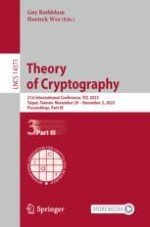2023 | OriginalPaper | Buchkapitel
Anonymous Permutation Routing
verfasst von : Paul Bunn, Eyal Kushilevitz, Rafail Ostrovsky
Erschienen in: Theory of Cryptography
Verlag: Springer Nature Switzerland
Aktivieren Sie unsere intelligente Suche, um passende Fachinhalte oder Patente zu finden.
Wählen Sie Textabschnitte aus um mit Künstlicher Intelligenz passenden Patente zu finden. powered by
Markieren Sie Textabschnitte, um KI-gestützt weitere passende Inhalte zu finden. powered by
Abstract
-
Improved computational efficiency (quadratic to near linear): Our protocol matches the communication complexity of [SW21] for each sender/receiver, while reducing the computational overhead for the router to polylog overhead instead of linear overhead.
-
Relaxation of assumptions: Security of the protocol in [SW21] relies on the Decisional Linear assumption in bilinear groups; while security for our protocol follows from the existence of any rate-1 oblivious transfer (OT) protocol (instantiations of which are known to exist under the DDH, QR and LWE assumptions [DGI+19, GHO20]).
